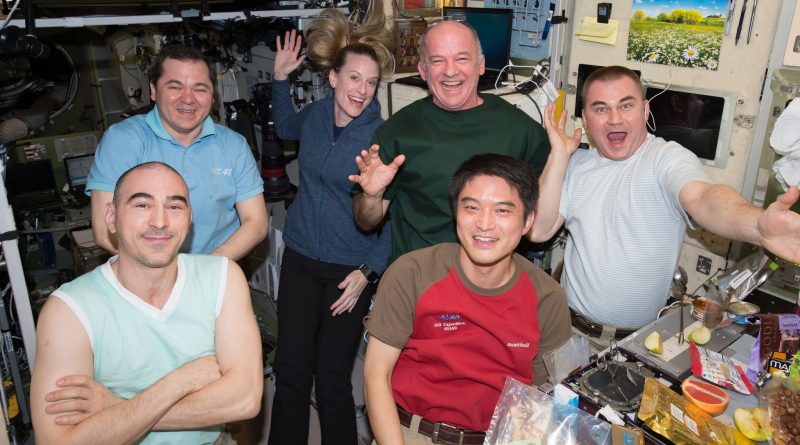Cosmonaut Duo & U.S. Record Holder to land in Kazakhstan Wednesday Morning
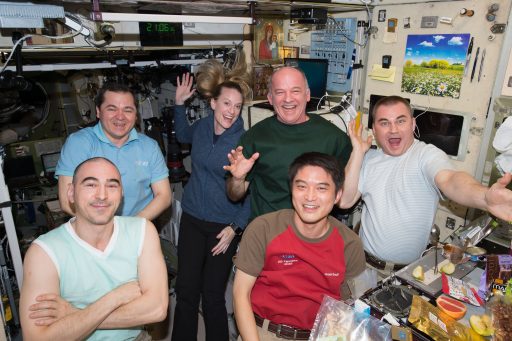
Three International Space Station crew members are gearing up for their return to Earth after 172 days in orbit, hurdling through the atmosphere in a blaze of fire surrounding their Soyuz TMA-20M spacecraft.
Soyuz Commander Alexey Ovchinin and Flight Engineers Oleg Skripochka and U.S. spaceflight record holder Jeff Williams are expected to make an early morning landing in the Kazakh steppe at 1:13 UTC on Wednesday, departing ISS three and a half hours prior.
The six International Space Station crew members were to gather on Monday for the traditional Change of Command Ceremony during which Expedition 48 commander Jeff Williams was to hand the position of ISS Commander to veteran Cosmonaut Anatoli Ivanishin who will lead Expedition 49 until his landing in November. Remaining on ISS after Tuesday night’s landing are Ivanishin along with Flight Engineers Kate Rubins and Takuya Onishi.
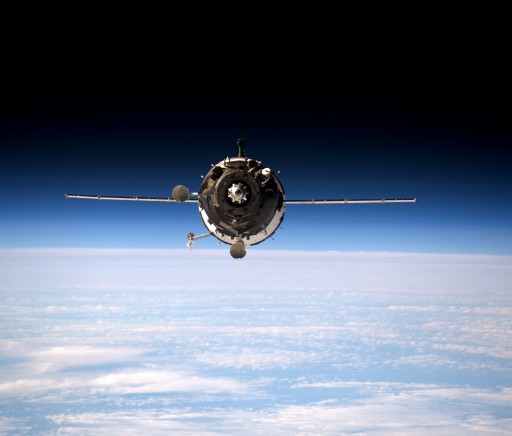
The crew will part ways at 18:30 UTC on Tuesday when the three returning crew members will board their Soyuz and close the hatch to ISS for the usual leak check operation ahead of the night’s planned undocking time of 21:51 UTC. Drifting away from ISS, Soyuz will fire its thrusters to open a gap prior to initiating its deorbit burn at 0:21 UTC in order to hit the brakes and drop itself out of orbit. Landing is aiming for the southern landing zone with touchdown scheduled less than half an hour after sunrise.
Ovchinin, Skripochka and Williams set sail on their journey on March 18 as the last crew to ride a Soyuz TMA spacecraft that is being retired in favor of the modernized Soyuz MS that features a number of improved systems. Their mission began with a smooth nine-minute ride into orbit followed by a high-speed link-up with the Space Station less than six hours after lifting off.
During their tenure on ISS, the crew supported over 200 scientific studies in progress board the orbiting outpost and oversaw a number of visiting vehicle operations including a Progress rotation, the arrival and departure of the Cygnus OA-6 resupply mission, and the Dragon SpX-8 cargo craft which delivered to ISS the Bigelow Expandable Activity Module.
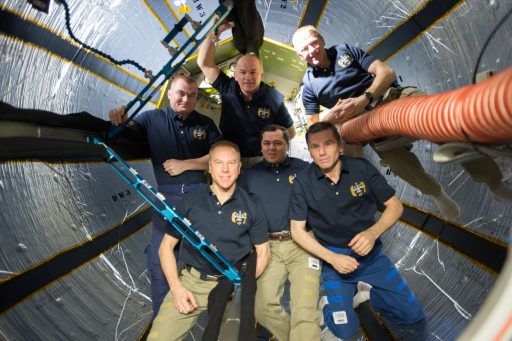
BEAM became a temporary addition to ISS in April when the module was removed from Dragon and installed on the Node 3 module. The first human-rated expandable habitation module took shape in May in a careful expansion procedure leading up to the crew’s first ingress a few days later, marking the start of a two-year demonstration mission.
Another major addition to ISS – International Docking Adapter 2 – was delivered by the Dragon SpX-9 spacecraft in July. It was installed on the station’s forward docking port last month to establish the first Commercial Crew docking port on ISS.
Closing out a busy mission, Jeff Williams – visiting ISS for the fourth time, added to his spacewalking record in a pair of EVAs performed with Kate Rubins. The first EVA saw the successful installation of the docking adapter while the second, performed last Thursday, had the crew venturing out on the Station’s truss to retract a spare thermal radiator and install a pair of HD cameras.
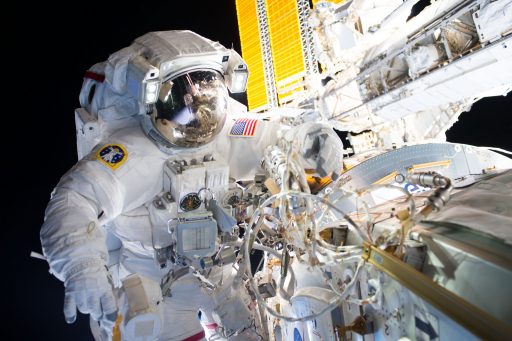
The two HD cameras were put to good use in the run-up to Tuesday night’s landing, being employed for an external inspection of the Soyuz spacecraft to ensure the vehicle was in good shape for its return. A previous survey performed on August 29 made use of the cameras on Canadarm2.
With their mission approaching its tail end, the Soyuz crew members adjusted their exercise schedules to better prepare for their return to gravity. They also loaded the Orbital Module of the Soyuz with disposal cargo and placed return items into the small Entry Module. Return items typically include hard drives with science data and various samples from ISS ambient air, water and surface swabs. Time-critical science samples from different experiments are to be loaded shortly before hatch closure for an express return to Earth.
The Soyuz trio also went through checks of their equipment including a fit-check of their Sokol Launch and Entry Suits and Kazbek seat liners in the Entry Module. They also completed a descent drill in normal and emergency mode to make sure all crew members would be on the same page and they tagged up with the recovery team. Because of ongoing crop harvesting in the Northern Landing Zone, Soyuz will land in the southern zone and the crew was informed that short-lived fires can be expected near their spacecraft after landing due to persistent dry conditions in the area.
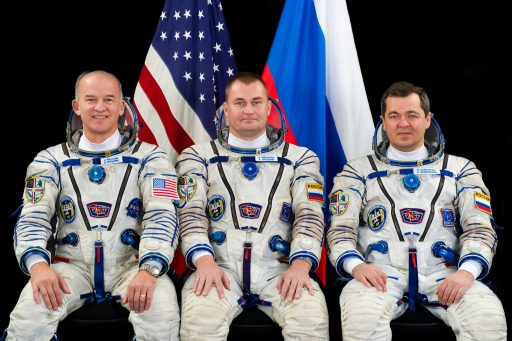
The crew will have a quiet day on Tuesday with a long mid-day sleep period to rest up for their overnight departure and return. Soyuz activation will be performed earlier in the day ahead of communication checks with Mission Control and final checkouts of the Soyuz vehicle, following up on an earlier test that verified all of the craft’s thrusters are still operational.
Parting ways at 18:30 UTC, the crews on either side of the hatchway will close their hatches to seal off the Soyuz spacecraft and Poisk module. Venting the air from the docking interface, the crew will read out pressure readings every five minutes to ensure there are no leaks on either hatch. The crew then puts on their Sokol suits and moves into the Entry Module for the final pre-undocking checklist.
Inside the confined space of the Entry Module, commander Alexey Ovchinin will take the center seat, preparing for his very first Soyuz landing. Oleg Skripochka, in the left seat, will be looking forward to his second Soyuz return, concluding his second long-duration flight. The most experienced of them all, Jeff Williams, will ride in the right seat, closing out his fourth space flight, the third on the Russian Soyuz.
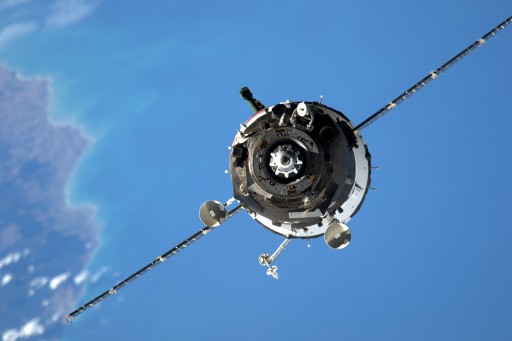
Williams recently set the record for most time spent in space by a U.S. Astronaut – 534 days at landing. He is one of only a few Astronauts who have seen ISS in its infancy, only comprised of two modules, and at its full utilization stage as an out-of-this-world laboratory.
With all three crew members in the Entry Module, the internal Soyuz hatch is closed and a leak check on the module is run followed by a verification of suit integrity by all three crew members. Soyuz will transition to autonomous power and communications switch to radio before hard-line interfaces are demated within the docking interface.
Hooks on the Poisk module will open up so that Soyuz will be only held in place by its own docking mechanism. The Space Station will remain in its duty attitude for the undocking as has become standard procedure to save ISS propellants that would be expended during a re-orientation to point the Soyuz to the velocity vector. Not moving ISS creates a slightly more complex Soyuz departure with two separate engine burns instead of only one departure maneuver.
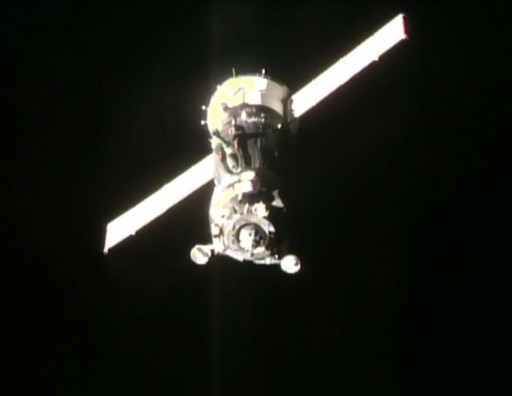
The docking mechanism will power on five minutes ahead of separation and the crew will issue the last set of commands to set up for undocking. ISS will disable the Russian Thrusters and command the USOS Control Moment Gyros to a Fine Attitude Hold mode for the undocking sequence, avoiding any unexpected motion by the Station.
The undocking command will be issued at precisely 21:50 UTC, triggering Soyuz to drive open its hooks leading up to physical separation 90 seconds later, accomplished by loaded springs that push Soyuz and ISS apart with a force of 300 Kilograms.
Upon separation, Soyuz will drift passively for three minutes while the crew reports on the status of the Poisk docking mechanism to ensure there is no damage or foreign objects. A departure burn of eight seconds occurs when Soyuz is 20 meters from ISS, generating a thrust component on the R-Bar to accelerate the opening rate. Next is a roll maneuver that positions the thrusters for the second departure burn that initiates the typical trajectory away from ISS along the V-bar.
With Soyuz out of the Station’s vicinity, the crew can relax for one and a half hours before beginning the setup for their return from orbit. Over the course of one and a half orbits, Soyuz will open a 12-Kilometer gap to ISS, but maintains a VHF link used to relay communications between Mission Control and the spacecraft.
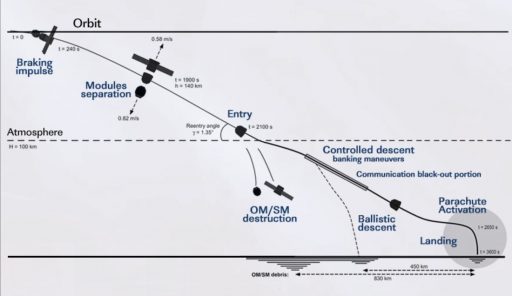
To begin the preparatory steps for the deorbit burn, the crew activates the accelerometer of the vehicle and connects the Entry Module batteries to the power bus. Burn parameters stored in the digital flight control system will be verified and the crew will watch over the re-orientation that points the tail end of the Soyuz toward the direction of travel ahead of the opening of the main engine cover.
Ignition of the SKD main propulsion System is set for precisely 0:21:26 UTC for a burn of four minutes and 41 seconds, designed to slow the Soyuz by 128 meters per second. Hitting the brakes, Soyuz will place itself onto a precisely calculated trajectory intercepting the dense atmosphere.
The burn has to be performed very accurately to set up the proper entry angle and ensure Entry Interface occurs within a narrow corridor from where Soyuz can reach its planned landing site.
Upon completion of the burn, the crew will close their helmets to get ready for the depressurization of the Orbital Module which is done after Soyuz is committed to re-entry in order to avoid an explosive release of air when the modules of the Soyuz separate.
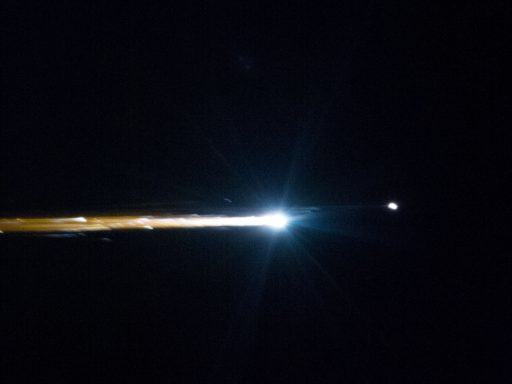
Flying from south-west to north-east, Soyuz will pass over Africa, quickly losing altitude on its way to a speedy re-entry. Separation of the modules is set for 0:48 UTC, 140 Kilometers above the Red Sea and accomplished by a series of pyrotechnics that fire in close succession to free up the three modules of the Soyuz. Springs send the modules off into opposite directions so that re-contact can be ruled out.
Immediately after the Entry Module is free it will begin using its eight Hydrogen Peroxide thrusters to point its heat shield forward and enter a pre-programmed entry orientation which it will hold during the initial port of re-entry.
Soyuz will hit the atmosphere at 0:51 UTC over northern Iraq at a speed of 7.6 Kilometers per second. For the first 93 seconds of re-entry, Soyuz will stick to a fixed attitude before enabling Entry Guidance to modify its lift to fly out any along-track errors and also correct cross-track errors, constantly computing its path to the targeted parachute-opening target.
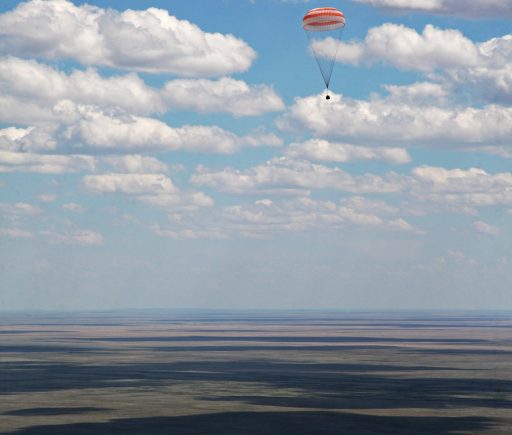
Barreling down in a blaze of plasma, Soyuz will rapidly slow down pulling up to five Gs when flying through an altitude of 40 Kilometers. In the dense atmosphere, Soyuz is decelerated to subsonic speed for the opening of the parachutes 10.7 Kilometers in altitude, starting with a pair of Pilot Chutes that pull out the Drogue Chute, violently shaking the capsule for around 30 seconds before stabilizing.
Slowed to 80 meters per second, Soyuz deploys its large main chute to transition to a vertical descent and slow down for touchdown. The automatic landing program will command the Soyuz through the separation of the heat shield, the jettisoning of the blackened window covers, venting the Hydrogen Peroxide tanks and equalizing the cabin pressure.
Soyuz is aiming for a remote landing site 148 Kilometers south east of the town of Dzhezkazgan and will fire solid-fueled Soft Landing Engines when touchdown is imminent, targeted at 1:13:55 UTC on Wednesday. A 300-person recovery team will be awaiting the arrival of the crew in helicopters, all-terrain vehicles and off-road vehicles to begin rushing to the landed Soyuz craft.
Being helped out of their spacecraft, the three crew members will be greeted by sunny skies, marking the end of a busy space mission of 172 days and 3 hours.

